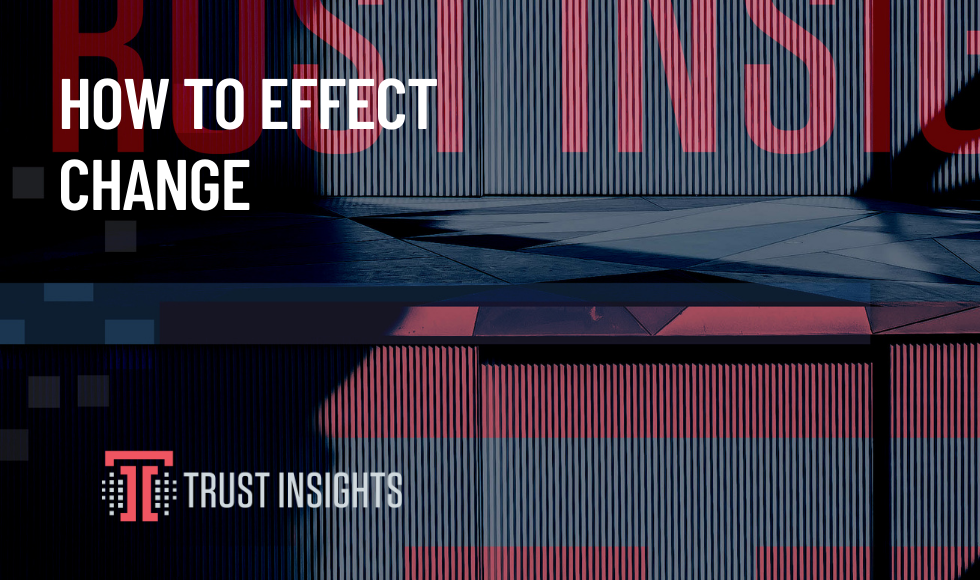Recently asked our slack community what questions they had about change management. This one stuck out to me as a very common issue:
“How do you effect change without authority?”
That’s an excellent question with a not so easy answer. Buckle up, this is going to be a long read.
I’ll start with – it depends. You have to factor in purpose, people, process, platform, and performance. The more complex each of those gets, the harder the change will be regardless of your role. The key points to remember are to 1) communicate the benefits of the change, 2) the risk of not making the change, and 3) options to approach the change. To do this, we’ll use the Trust Insights 5P Framework.
Let’s say you’re bottlenecked by executives. Maybe it’s your CMO that needs to approve all the social posts that go out or your plans to do an A/B test. It could be that you need to make changes to the MarTech infrastructure and you need IT to take part. Perhaps you’re locked into a 3-year strategy that your board approved but the market has changed and you need to adjust.
We’ll use the MarTech infrastructure example. This is a common challenge and has a lot of moving pieces.
Purpose: This is where you want to drive home the benefit, and even the risk of not making this change. For example – The purpose of making a change to the MarTech infrastructure is to increase the level of accuracy of our attribution models. If we don’t make this change, we run the risk of not being able to know which digital channels are working.
What you’re doing is helping the decision-maker understand the situation quickly.
People: Start with the bare minimum – the person who needs to execute the change and the decision-maker. You can build out from there. In this case, you’ll want to include those on the receiving end of the data, especially if the data that they have been getting will be changing. There needs to be a communication plan for those people, not only the decision-maker.
If you can get that group on board you’ll have an easier time convincing the decision-maker it’s not a big risk.
ProTip: Make sure you’re truly hearing the concerns of those involved. Talk through potential solutions to those concerns during planning. Factor those concerns and solutions into your plan.
Process: For the processes, you’ll want to outline what relates to your governance. This includes governance of the platforms, meaning who has access to what. Next is the governance of the data (current and future state), and how you’ll inspect the data for any issues once the changes go through. Last, outline if the method to extract the data change at all.
If there will be minimal changes to each process step, make sure you walk through that and why. Conversely, if the changes are more complex consider an incremental approach. Start with one setting or data point at a time. Let that change setting for a week or two. Making your process iterative allows time to get the people involved comfortable with the changes piece by piece.
Platform: If you’re wanting to make some kind of infrastructure change, be sure to think through all the other platforms the change will touch. Walking through all the platforms will help you get ahead of any possible side effects of the proposed change. This will also lower the risk of surprises.
Performance: This is your opportunity to reiterate the benefits in a measurable way. Emphasis on measurable. This is going to look different for each project. If your purpose is to change the data collection mechanism in a platform to make your attribution more accurate, be sure you can measure that. This means you need to talk through why it’s not currently accurate.
Defining the measure of success ahead of starting a project will help you track against the purpose and keep the project focused.
If you’re still with me, and I hope you are, to effect change when you have no authority, you have to make the case and defend it. Help people understand why the change is important to them, the business, and the customer. Outline the risks to not making the change.
The 5P structure operates as a mini business case for the change you want to make. Use this structure to organize your requirements and communicate to all involved. Provide options to approach making the change more palatable.
Have you tried to make a change in your organization? Tell me about it in our free slack group Analytics for Marketers.
|
Need help with your marketing AI and analytics? |
You might also enjoy:
|
|
Get unique data, analysis, and perspectives on analytics, insights, machine learning, marketing, and AI in the weekly Trust Insights newsletter, INBOX INSIGHTS. Subscribe now for free; new issues every Wednesday! |
Want to learn more about data, analytics, and insights? Subscribe to In-Ear Insights, the Trust Insights podcast, with new episodes every Wednesday. |






